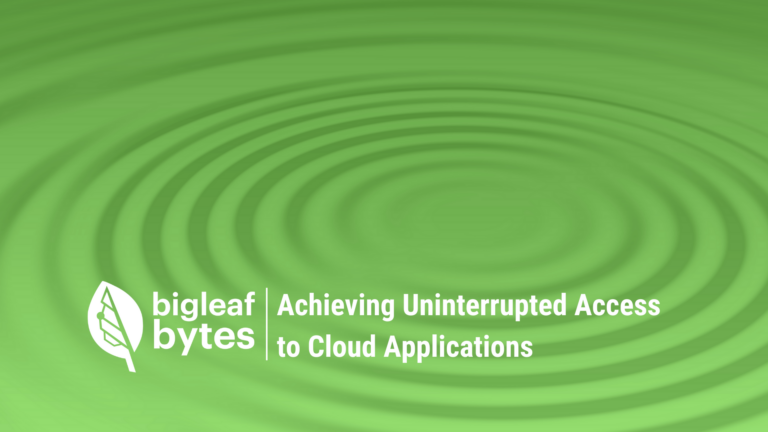How to build a cloud-ready network
Matrix Networks got its start in 1984 supporting and installing PBX phone systems. Over the years, the company’s embrace of internet technologies and cloud computing solutions has helped its customers navigate a constantly evolving network landscape.
Matrix Networks attributes this success to the company’s principled approach to cloud-ready network solutions based on three decades of experience.
In an interview with Bigleaf, Kyle Holmes, president of Matrix Networks, explained the company’s strategies for moving customers to the cloud.
As companies shift their businesses to the cloud, what are some of the things you’re seeing?
A lot of people don’t realize they are already in the cloud. In fact, many of them are farther along on their cloud journeys than they think they are. That’s because every business application is moving to the cloud. Every application on a desktop has a web version today. That has resulted in an increase in IT sprawl, as the cloud makes it easy for individual departments to make their own buying decisions.
Is there a secret formula you’ve found for building a cloud-ready network?
There’s a right way to build a cloud-ready network. We call it Matrix Connectivity as a Service (MCaaS). Through a combination of purposeful network design, disparate circuit sourcing, and SD-WAN optimization, we’re able to intelligently manage a customer’s internet bandwidth. From carrier-agnostic circuit sourcing to built-in, company-wide redundancy, 24/7 support and monitoring, and consolidated billing, MCaaS has simplified the way our clients experience connectivity, allowing them to focus on what matters: their business.
We’ve had a lot of success because we’re principled about our approach to what it takes to build a cloud-ready network. Customers want something easy that just works and they want one partner for their connectivity strategy. It’s why our MCaaS is so popular. It’s what our customers want because it’s everything they need in one package with one bill.
What role does SD-WAN play in the solutions you deliver to clients?
In many client engagements, we’re seeing SD-WAN displace existing MPLS networks because SD-WAN delivers better reliability, more speed, and cloud access. And beyond the technical benefits, SD-WAN makes it easy for company IT managers to migrate their applications on private networks to the cloud, giving their own customers — the users — better speed, reliability, and access flexibility. It’s always good to remember there’s usually a human at the other end of your solution and anything you can do to make their life easier is a good thing.
Are companies you work with aware of SD-WAN or is this something you introduce to them?
A couple of years ago, if you mentioned SD-WAN to someone it would be the first time they had ever heard of it. Today, everyone’s heard of it, but nobody understands it. That’s largely due to the fact that there’s a lot of market confusion around the term where people think they’ve got what they need and they really don’t.
SD-WAN is a broad term that means different things to different people. In our case, customers don’t come looking for SD-WAN, but we’re able to show them why they need it.
Your approach to SD-WAN is different than a lot of companies in the market.
For us, SD-WAN takes on two plays: One, we took a hard stand to require SD-WAN in every UCaaS solution we sell. That’s non-negotiable for us. Because deploying UCaaS without SD-WAN is like driving a car without a seatbelt.
The other is as an MPLS displacement where companies are migrating applications to the cloud from a private network and realize they suddenly have different security and reliability requirements.
What makes Bigleaf different?
There are three network connectivity types: site-to-site, cloud-based, and hybrid SD-WAN. Companies can live off a single dumb pipe and hope nothing goes wrong. But we all know that networks inevitably go down. Or they can create a better experience using SD-WAN.
Bigleaf falls right in that cloud SD-WAN sweet spot. There aren’t many that do, fewer that do it well, and none that were built specifically for the cloud like Bigleaf.
To put it bluntly, Bigleaf is an upgrade to the internet. Bigleaf allows companies to migrate to the cloud with minimal changes to their network or existing firewall infrastructure. It’s simple and it works. And that’s why we’ve made it a mandatory part of our offering and also why it sells so well.
What advice would you give to others?
It’s easy to fall prey to the marketing around the cloud and SD-WAN. You need to find a partner who has sifted through the sand for you. When you find that partner, pay attention to the dashboard experience they offer. Visibility is important.
And remember, carrier networks go down. Don’t be dependent on just one. When CenturyLink went down last year, 80% of our clients were on their network. None of them called us. And a big reason they didn’t was because they had Bigleaf as part of the solution we built for them.







